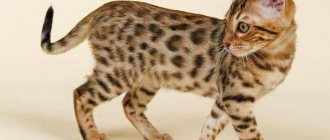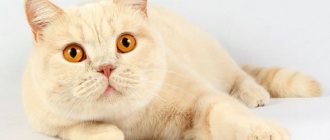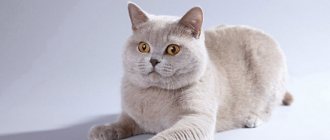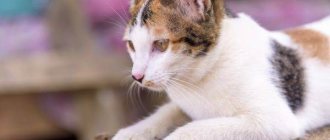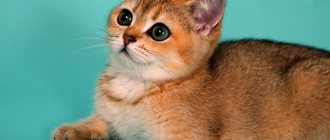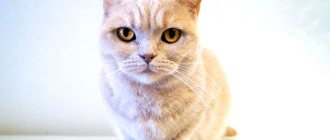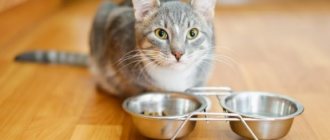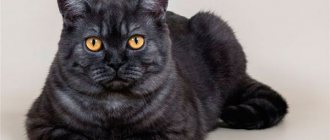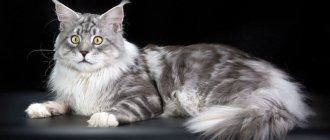All cats of the British breed can be divided by color into 6 groups (solid, tabby, smoky, tortoiseshell, bicolor and color point). Animals with a marbled coat have appeared recently and are part of the tabby group. Until now, they have not become stable in breeding, and therefore are considered rare and expensive.
Let's find out how the British merle coat differs from other representatives of this breed.
Features of color and types
All cats are tabby or spotted, but not all have this pattern visible. Even black animals have the same stains on their fur. The British merle color fully complies with this rule.
- Brindle. The most common type is when a pattern of thin stripes is visible on the surface of the coat. The symmetrical lines of the “necklace” converge around the neck, “ribs” are drawn from the spine to the stomach, and 5-7 narrow rings are placed on the tail. The conventional repetition of the tiger skin pattern gives this color its name.
- Spotted (leopard). It is characterized by broken lines in the form of spots of various lengths and configurations. They do not form a clear pattern and appear in fragments: the “necklace” is more likely to be guessed, a line of spots stretches between the withers and the base of the tail, and a row of “buttons” appears on the belly.
- Abyssinian ticked. Here there is no pattern at all, and it is replaced by small ripples (freckles) on the fur. Residual striping is allowed only on the paws and tail, and the “necklace” on the neck has an open appearance.
- around the neck are the lines of a massive necklace;
- There are three wide strokes from the neck to the tail;
- the tail is ringed 3-5 times;
- large “buttons” along the belly.
All of the listed colors are inherent in the breed of British cats - about 250 different colors are allowed in a single color or in combinations.
Marbled cats have a pattern similar to a tiger cat, but with a significant addition: the lines are wider and clearer. There is a “butterfly” visible on the back, and large rosettes on the sides – “eyes”.
British marbled cats are presented in 4 types and the color designation in them depends precisely on the color of the lines.
These colors are found in marbled British cats. Chocolate, cinnamon, lilac and fawn, allowed in other populations, are prohibited for aboriginal cats.
The next subspecies of merle color concerns two-color tortoiseshells. This coloring occurs when there is a combination of the dominant and recessive red gene Oo in the cat’s genotype. It is absolutely characteristic of marbled British girls, as it joins two female X chromosomes.
This process should be considered in more detail on red colors, and for the overall picture only one note is important - tortoiseshell marbled kittens are represented exclusively by the female sex.
Male cats can acquire a similar coloring in one case - if they have an extra X chromosome, which automatically classifies the animal as infertile.
“Turtles” are distinguished by a more complex genetic formula of marbled color and among the British they are presented in only 2 colors: black and blue. All other combinations (chocolate, cinnamon, lilac and fawn) indicate interbreeding and are mercilessly fined at exhibitions.
It is important! All marbled British cats have a common feature - a large letter M on their forehead. There are various legends about her appearance - either Mohammed took her in his arms, or Magdalena tried. But it is unlikely that these fairy tales have anything in common with the truth - natural nature is much more diverse than one can imagine.
Genetics of tabby color
Thanks for the patterned colors should be the agouti gene (A), responsible for the presence of the pattern, and the tabby gene (T), responsible for the nature of the pattern.
There are four genes in total:
- Ta – ticked;
- T – striped or spotted;
- tb – marble.
Dominance:
- Ta dominates over T and tb colors;
- T is dominant over tb color;
- tb – recessive color.
Formula:
- AA - tabby, such an animal will always produce offspring with patterns;
- Aa - tabby, this animal can produce kittens with or without a pattern;
- aa is an animal without patterns, the offspring from it, accordingly, will also be monochromatic.
Spotted tabby (leopard)
With the help of the tabby gene and a set of polygenes, which seem to break the patterns on the cat’s body, a spotted color is formed. The spots contrast with the main color of the animal and are clearly defined, do not merge or intersect. The striped color becomes mottled even with little exposure to polygenes. This explains why spotted cats are much more common. The merle color is not so afraid of the effects of polygenes, because it will be considered spotted only if it is completely divided into clear spots of small sizes. By the pattern on the coat, it is most often noticeable from what color the spots were formed.
BSH n 24
Classic, blotched | marble tabby
It is a form of the tabby gene (tb). It is distinguished by its extraordinary beauty and rarity. The drawing is rich and contrasting. The butterfly-like pattern on the shoulder blades is one of the main distinguishing features. There are wide stripes along the ridge of the animal, and expressive large spots adorn the sides. It has a modification of marble, characterized in that it has a less pronounced middle and pronounced edges.
Red marble BRI d 22
brown tabby BRI n 22
Black marble silver ns 22
silver tabby BRI ns 22 64
Tiger, maskerel tabby (tiger)
This type of pattern is rare among tabby cats, but not as rare as merle. From head to tail there is a straight wide line, from which frequent, unbroken narrow stripes extend. The stripes tend to tear and then the tiger color turns into leopard, which is the reason for the rarity of the striped variety. Formed using the T gene.
Ticked tabby
The Ta genome is formed, which is dominant among all others. With this color there are practically no patterns, and the entire body is covered with ticked (striped) hairs. Despite the dominance of the gene, it is quite rare, being a gift from the Abyssinian breed, which does not currently exist. The value of this color is the intensity of the main tone of the animal’s coat and the undercoat of pleasant delicate shades.
BLH ns 25
ds 25 red silver ticked
Disadvantages of tabby color: “torn”, unclear and asymmetrical pattern, absence or non-closed rings on the neck. For light-colored animals, a brown or grayish undercoat color is unacceptable.
Eyes: Shades of orange or emerald eye color are acceptable, based on the basic tone of the British cat.
"Silver" and "gold" tabby
If you pay enough attention to the background, and not just the pattern, then the patterns on the wool take on a beautiful appearance. With the help of additional polygenes, you can give the undercoat a copper tone. Add a golden and unusual hue. And if you influence the pattern with the Silver gene, the tone will change to a pronounced pearl color and become silver.
Cons: There are many requirements for the golden and silver shade of the undercoat. So “gold” should have a color without any admixtures of brown and gray, and “silver” should have no yellow tint. The yellow discoloration that most often appears on the nose, paws and chest is called ruffism. It has been observed that breeds in which the fine “gold” silver contains rufisms, and in the pedigree with good “silver” the “gold” has an inappropriate undercoat color.
Eyes: “gold” must have green shades of eyes, “silver”, in addition to green, may have orange.
Moire or drawing?
When the Aguti gene does not have the proper effect on color, the cat's color becomes flat and without a pattern. The pattern on such cats is visible as moiré, despite the fact that at birth it was quite contrasting. A similar effect is observed in lion cubs and cubs of other feline species. There is a pattern in the genotype of any cat, but in order for it to appear, the influence of the Aguti gene is necessary.
Disadvantages: the disadvantages of cats without a pattern are the features of their patterned counterparts - incomplete moire, uneven coloring of the coat along the entire length. In adult cats, moire should be absent.
Eye color: copper, others are not acceptable.
There are polygenes that eliminate moire, because of this the moire pattern becomes either completely invisible or too bright, which misleads breeders. The cat appears to be tabby in color, which is not the case.
Distinguishing a pattern from a moire pattern is not as difficult as it seems. In tabby, the patterns are bright and contrasting, while in moire, they differ from the main type of coat by only a few tones.
SFL n 22 03
BRI h 22 – chocolate tortoise marble
Genetics of merle color and the history of its appearance
To obtain the color, interbreed matings of English cats with Persians and exotics were used. Outwardly, they are very similar to the British, so they did not spoil the breed, but only transferred the genetic properties of the color. There are known cases of Egyptian Mau and even American smooth-haired animals being included in the process.
Later, when a large group with the required color parameters had gathered, extraneous animals were excluded from the breeding program.
The main phase of selection took place almost a century ago, so by now the marbled ones have already been thoroughly studied, and nurseries from generation to generation are guaranteed to receive the required color.
It is necessary to begin studying the process with the tabby trait, which forms any pattern on the coat.
Another gene is agouti (A), which performs two functions. In the dominant form, it opens the way for the tabby pattern, and in the recessive combination (aa) it suppresses T and the color in cats becomes solid. It is clear that all British shorthaired harlequins have a dominant variant A in their genetic code.
There are objective indicators that worsen the quality of color:
- excessive contrast between the pattern and the background fur;
- pattern blurred by ticking;
- broken stripes that do not form a continuous line;
- a drawing stroke that is too thick and overly covers the main tone.
It is important! The coat pigmentation of British harlequins can vary. In the main areas it is uneven and depends on the density of the capsules with the dye (eumelanin or pheomelanin) in the hair. In the drawing area, each hair is filled with pigment equally from root to tip, which provides a contrasting and rich color.
Characteristics of the Marble Briton
Experienced breeders rarely talk about the dependence of a cat’s character on its color. Some inexperienced owners may mistakenly consider Marbled Britons to be a different breed. However, these cats are British, which means they have all the character traits of this breed. They are smart, aristocratic, and wary of strangers. In addition, they are independent and self-sufficient and need human society less than others.
Differences between merle and other tabby colors
All differences in color combinations are only in the plane of visual perception of the combinations. Because of their wide lines and larger pattern, marbled tabbies are superior to brindle and leopard tabbies.
And when tortoiseshell two-color combinations come into play, the number of combinations cannot be counted. Standard tabbies cannot provide such characteristics, which does not prevent them from creating their own unique color compositions.
This is interesting! Although the merle color was introduced into the British breed later than others, it was designated as “classic” for cats of the British breed.
Video "British cat"
We advise you to watch the video starring the Briton of the color in question.
Sorry, there are no surveys available at this time.
Was this article helpful?
Thank you for your opinion!
The article was useful. Please share the information with your friends.
Yes (100.00%)
No
X
Please write what is wrong and leave recommendations on the article
Cancel reply
Rate the benefit of the article: Rate the author ( 4 votes, average: 5.00 out of 5)
Discuss the article:
False marbling or moire
Sometimes genetics plays a cruel joke on marbled cats - agouti (gene A) manifests itself not in a dominant, but in a recessive state.
The British merle cat produces offspring that in childhood are very similar to real representatives of their species. Only the lines in newborn kittens are more faded and blurred.
Conversations that in the future the moire will fade and the coloring will return to normal are carried out by complete ignoramuses in cat breeding or scammers. Over time, the false marble will not go anywhere, it will acquire a shade of the main color and remain that way for the entire cat's life.
There may be 1-2 false marbled animals in a litter. In the first case, it is very easy to identify a “defective” baby - he is clearly different from his brothers and sisters. And when 5-7 identical moire children are near a real marble cat-mother, you can easily make a mistake.
If there is the slightest doubt, experts have only one recommendation - it is best to go to another nursery and look at another litter. If the buyer is convinced of the identity of the kittens, then he can decide which breeder to purchase them from. And the probability of getting two completely moire marble offspring in practice is zero.
British merle color: features of the breed
The first cat show, held in 1879 in London, was attended by the British. Since then, plush animals have gained considerable popularity, as kittens were actively bought by foreign breeders and taken outside the country. The breed, despite its long existence, was officially recognized only in 1950.
At the end of the 70s of the last century, a document was created prohibiting breeding them with any other felines. And in 1980, aristocrats received recognition from the FCA Association.
According to the standard, a purebred individual must have:
- Proportional, strong body with clearly developed muscles, squat and dense.
- Large head with wide-set, medium-sized ears (rounded tips).
- A fold around a short massive neck.
- Big round eyes. The color of the iris is predominantly amber-orange, less common is green and blue. Babies have gray-blue eyes, changing color as they grow older.
- Wide chest.
- Well-defined cheekbones, pronounced cheeks, developed chin and wide nose.
- Thick undercoat.
- The coat is short, dense with hairs of equal length. It feels like plush.
- Neat, strong, rounded paws corresponding to the body type.
- Fleshy, medium-length tail with a rounded tip and a wide base.
The British are distinguished by their long lives, often reaching 15-20 years of age. The weight of an adult animal ranges from 5 to 8 kg; height is not indicated in the standard, but must correspond to a dense constitution.
Marbled British Fold cats
A very common misconception that needs to be addressed. In fact, there are no marbled British Fold cats:
This is interesting! The Scots have all types of merle colors of their British ancestors and those that are prohibited to the aborigines: chocolate, lilac, fawn and cinnamon.
The Difficulties of Breeding British Marbleds
During pregnancy, which lasts 63 days, the cat should be fed well, but not allowed to overeat. Excess weight puts extra strain on the heart. Females usually give birth on their own. It is advisable for an inexperienced owner to agree in advance with the veterinarian about the possibility of a home visit in the event of an unforeseen complication.
Be sure to read:
What food should you feed your adult Scottish Fold cat and kitten?
Often, when crossing British cats, kittens are born that breeders, out of ignorance or for profit, sell as marbled, although in fact they are moire. It is easy to distinguish one from another. Tabbies are patterned in a color different from the main one, and moire specimens are painted in a darker shade of the “base”; over time they will become monochromatic.
How to get marbled kittens
A recessive gene is responsible for this color, so to get tabby kittens it is necessary to mate parents with the same coat.
A merle litter can be obtained from the mating of a spotted individual with a brindle, two brindles, or a pair of spotted ones if they both carry the recessive gene.
Character and habits of the marbled British and Scots
The differences in behavior and manners between the two English breeds are as significant as their external characteristics. Scientists reasonably question the influence of color at this point, although cat owners say that coat color and character still complement each other.
The British are touchy, proud, selfish. They prefer solitude and do not like to be the center of attention. Large companies make them wary, general games do not attract them, and English cats do not really like to communicate with their owner.
However, Britons can be good companions and grateful pets. To do this, you need to respect his personal space and discard the belief that the animal is obliged to do only what the owner tells him. Having thoroughly enjoyed the solitude, the Briton himself will want to express his gratitude and will find time to sit around people. Only this way, and no other way.
The Scottish branch is the exact opposite. Fold cats are sociable, kind, affectionate, and playful. They get bored alone, adore their owners and other family members, and get along well with any pet.
As for the influence of marble color on character, there are options:
- It is believed that black Britons are more cunning than cats of other colors.
- Redheads are prone to cunning, especially in adulthood, when they gain experience.
- The blue ones are the kindest of all, adjusted for their disposition. This means that they can tolerate familiarity longer, but their patience is not unlimited.
Experts have a more specific opinion about Scottish Fold cats - they are affectionate and sociable, regardless of color.
Features of mating marbled British
Cats in their first heat are not allowed to mate; the body is not yet ready to bear viable offspring. It is optimal to schedule the denouement for the third mating season. A partner should be selected in advance; for breeding, a candidate is sought in the club. It is advisable for a young female to be provided with a partner with experience.
Before this, both of them must be wormed two weeks in order to avoid infection of kittens with helminths during birth. The mark on comprehensive vaccination and rabies injection must be made no earlier than a month before the intended date and no later than a year. A cat's claws must be trimmed before mating.
During mating games, the female often slaps her gentleman in the face with her paw; such a preventive measure will help avoid eye injuries in case of an unsuccessful hit.
The cat is brought to the male, it is advisable to provide her with her own bowl, tray, transportation, where she can retire to rest. Some ladies need time to adapt to new conditions, but after an hour or two, instinct will prevail over caution.
Owners sometimes enter into written agreements on the temporary transfer of the animal into someone else’s hands, which also stipulates the conditions under which mating takes place (free of charge, for money, a maintenance kitten, etc.). The paper eliminates controversial issues in the future. If pregnancy does not occur, the other party should be notified.
Recommendations for care and maintenance
The rules for caring for the coat and maintaining a marbled British or Scotsman are the same as for other representatives of the English breed.
The British and Scots are unpretentious eaters, but capricious colors sometimes react to the diet.
With the main light color of merle colors, it is not recommended to get carried away with seafood, although cats love them very much. Excess iodine immediately covers the white areas with a yellowish tint, which will disappear as soon as the menu is balanced.
Trace elements of copper give a reddish tint, and excessive consumption of poultry by-products manifests itself in the form of a gray coating on the animal’s fur coat.
Types of colors
British tabby cats have light, muted tones as their main color. The drawing has a dark color that contrasts with the main one.
Lilac
The main color of the Briton is beige with a hint of purple markings. A special feature is the pink nose and pads on the paws, which look very gentle.
Silver
The British silver tabby cat has a delicate bluish tint. The pads on your pet's paws may have the same shade or pinkish.
Gold
The main shade is gold, and the pattern on the body is made in various coat colors several shades darker. Golden tabby is divided into several more types of color: black, blue, chocolate (brown) and color-point.
Blue
The main color of cats is a light blue tint, including not only the fur, but also the nose and paw pads. The color is interesting because it is dominant: when the offspring appear, most of the kittens will have exactly this color. A dark blue pattern is observed throughout the body.
Red
On the body, the main shade of which is cream or silver, there is a pattern of bright orange color (compared to a red sunset).
Appearance and standards
The Scottish marbled cat stands out among its closest relatives in its color, but otherwise the general standard of the breed is no different.
Dimensions and weight
The Scots have a strong, muscular body with pronounced, rounded features. The structure of their body resembles a rectangle, but despite its external massiveness the animal does not look clumsy.
The paws are neither short nor long, rounded, soft. The tail is long, bushy at the base and tapering towards the tip.
The head of the Scottish cat is round, located on a shortened neck. The breed usually has a short nose and pronounced, strong jaws. The general appearance is complemented by medium-sized round eyes, which make the animal seem surprised. The muzzle is framed by chubby cheeks, which are slightly lowered down.
Marbled Scots are practically no different from other representatives of the breed
The marbled fold cat is distinguished by the structure of its ears, which are curved down and pressed to the head, which is why the animal’s muzzle appears even more round.
Scottish straights do not have this feature, but remain no less remarkable: their ears are located high, even in structure and shape. They smoothly sharpen towards the top and seem to “look” in different directions.
The average weight of cats reaches 4 kg, males, as a rule, are slightly larger - 5 kg. The height of animals at the withers does not exceed 28-30 kg.
Popular colors
The merle color is presented as a contrasting pattern with pronounced spots on the sides and a “butterfly” shape on the animal’s back. The peculiarity of the color is that its borders are slightly shaded over the surface, in turn, the lines of the drawing never merge with the general background.
- The marbled tabby is characterized by stripes in the form of a “necklace” around the cat’s neck;
- The presence of three wide stripes between the neck and tail;
- The tail from base to tip is colored in rings;
- The abdominal cavity of a cat contains a mass of small marks (crumbs) in the form of “buttons”;
Scottish marbled kittens receive a pattern from the first days after birth, which remains unchanged throughout life.
You should not fall for the tricks of scammers who promise that the color will appear with age.
The marbled tortoiseshell color is considered the most traditional for representatives of the breed: it is a two-color tabby on a basic light background. In addition, the color can be black, blue, cinnamon, purple.
The latest experimental color for Scottish Folds and Scottish Straights was the lilac merle color:
- The general background of the fur is pale lavender, with a gray-pink tint;
- The color of the pattern is gray, with “gray hair” present at the edges;
- Lavender nose, paw pads;
- Amber, brown and copper eye shades;
- Rich lilac contour around the nose and eyes;
Lately, purple marble has gained the most popularity.
Signs of disqualification
There are signs of the color of the Scottish marbled cat that are rejected by felinologists:
- A fuzzy pattern, torn at the edges or blurred at the boundaries of contact with the general background;
- Pale marbled color, resulting in shades merging;
- Torn stripes, spots of different sizes;
IMPORTANT: unscrupulous breeders often claim that over time the marble will appear and take on its standard appearance. This is a deception: marble may change, but most likely these changes will be far from the breed standard. For this reason, you should purchase a kitten no earlier than it reaches three months of age.
Character of the breed
Marbled Scots have the character of typical representatives of the breed and do not inherit global changes in habits. Just like the Scottish Fold, they are smart, good-natured and playful, and their unusual coloration only adds zest to the general characteristics of the breed.
All Scots have a calm and homely disposition.
Scottish cats love the company of people very much; they are equally happy with their owner, family members, guests and small children. Sometimes it is difficult to imagine a breed that would be more patient and accommodating when dealing with small children. The same applies to other pets, to which the friendly Scot will show a healthy interest and his childish enthusiasm.
Scottish kittens get along quickly with small children and other pets
Scottish marbled cats love affection very much; they can spend hours basking in the arms of someone who will stroke them and ruffle them behind the ears. They are always an object of admiration and will never cause a headache.
